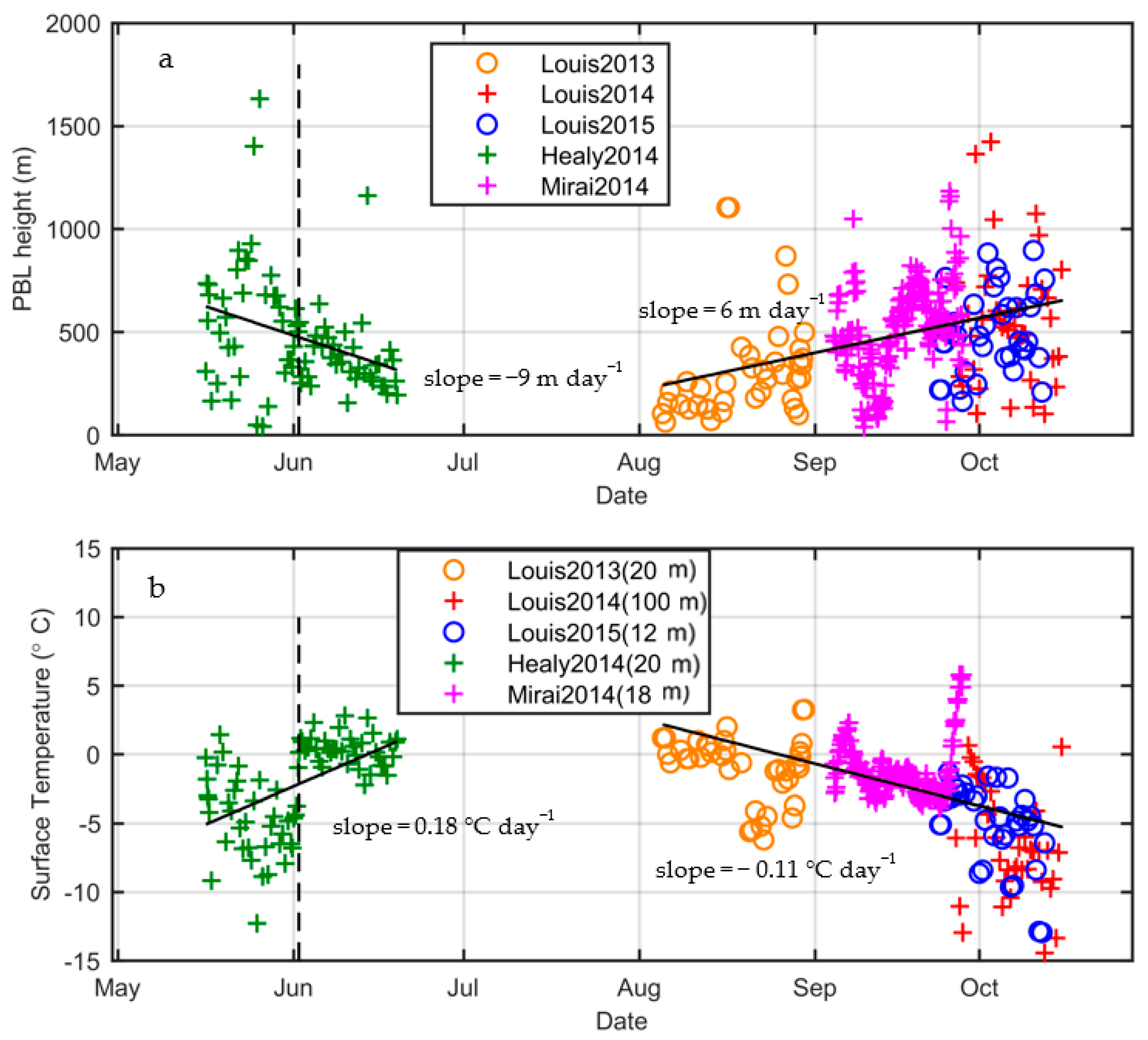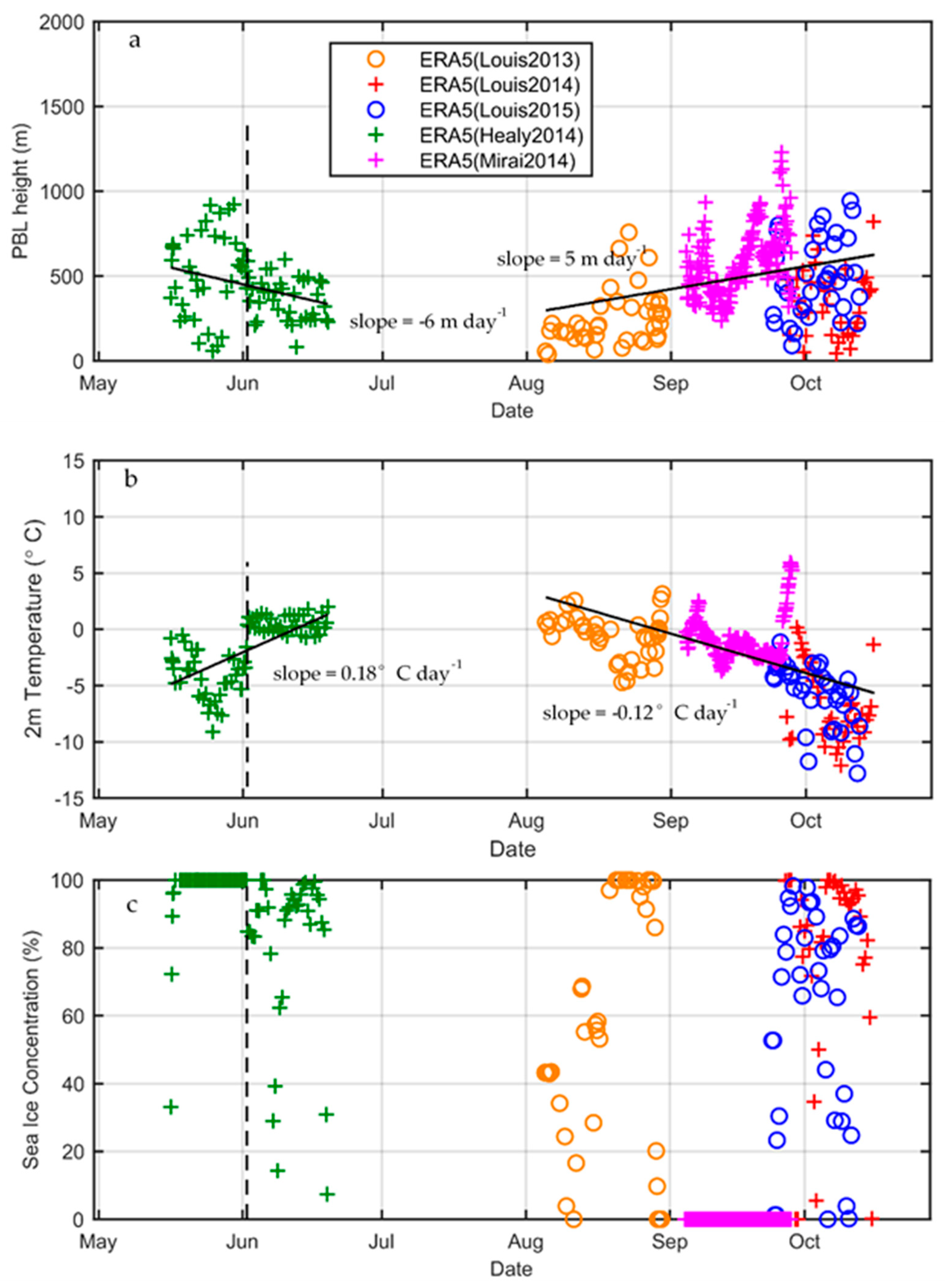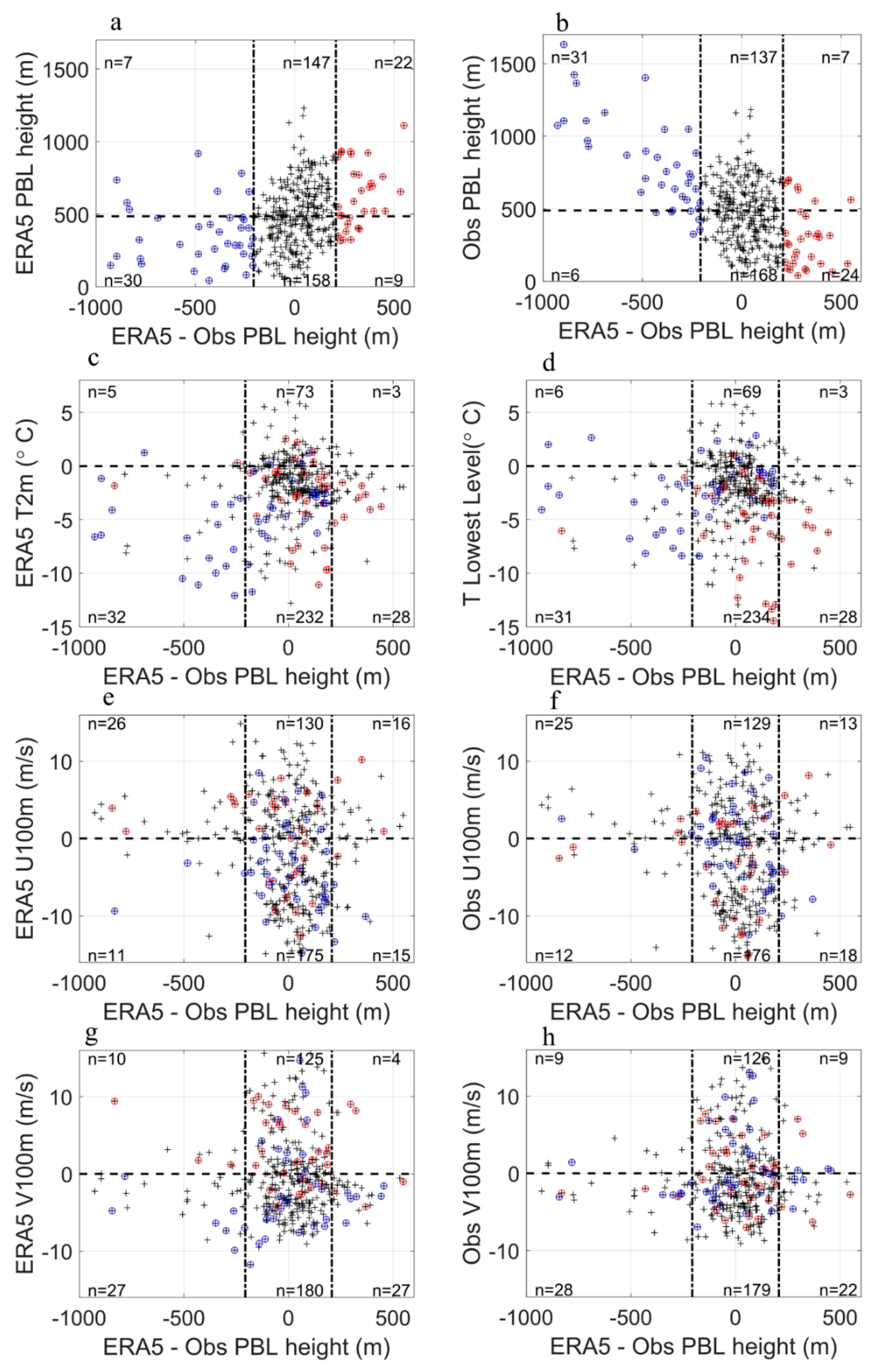Planetary Boundary Layer Heights from Cruises in Spring to Autumn Chukchi-Beaufort Sea Compared with ERA5
Abstract
:1. Introduction
2. Materials and Methods
3. Results
4. Discussion and Conclusions
Supplementary Materials
Author Contributions
Funding
Institutional Review Board Statement
Informed Consent Statement
Data Availability Statement
Acknowledgments
Conflicts of Interest
References
- Box, J.E.; Colgan, W.T.; Christensen, T.R.; Schmidt, N.M.; Lund, M.; Parmentier FJ, W.; Brown, R.; Bhatt, U.S.; Euskirchen, E.S.; Romanovsky, V.E.; et al. Key indicators of Arctic climate change: 1971–2017. Environ. Res. Lett. 2019, 14, 045010. [Google Scholar] [CrossRef]
- Johannessen, O.M.; Bengtsson, L.; Miles, M.W.; Kuzmina, S.I.; Semenov, V.A.; Alekseev, G.V.; Nagurnyi, A.P.; Zakharov, V.F.; Bobylev, L.P.; Pettersson, L.H.; et al. Arctic climate change: Observed and modelled temperature and sea-ice variability. Tellus A Dyn. Meteorol. Oceanogr. 2004, 56, 328–341. [Google Scholar] [CrossRef]
- Overland, J.E.; Wang, M.; Box, J.E. An integrated index of recent pan-Arctic climate change. Environ. Res. Lett. 2019, 14, 1–5. [Google Scholar] [CrossRef]
- Serreze, M.C.; Barrett, A.P.; Stroeve, J.C.; Kindig, D.N.; Holland, M.M. The emergence of surface-based Arctic amplification. Cryosphere 2009, 3, 11–19. [Google Scholar] [CrossRef] [Green Version]
- Serreze, M.C.; Francis, J.A. The arctic amplification debate. Clim. Chang. 2006, 76, 241–264. [Google Scholar] [CrossRef] [Green Version]
- Andersen, J.K.; Andreassen, L.M.; Baker, E.H.; Ballinger, T.J.; Berner, L.T.; Bernhard, G.H.; Bhatt, U.S.; Bjerke, J.W.; Box, J.E.; Britt, L.; et al. The Arctic. Bull. Am. Meteorol. Soc. 2020, 101, S239–S286. [Google Scholar]
- Cohen, J.; Zhang, X.; Francis, J.; Jung, T.; Kwok, R.; Overland, J.; Ballinger, T.J.; Bhatt, U.S.; Chen, H.W.; Coumou, D.; et al. Divergent consensuses on Arctic amplification influence on midlatitude severe winter weather. Nat. Clim. Chang. 2020, 10, 20–29. [Google Scholar] [CrossRef]
- Screen, J.A. Arctic amplification decreases temperature variance in northern mid- to high-latitudes. Nat. Clim. Chang. 2014, 4, 577–582. [Google Scholar] [CrossRef] [Green Version]
- Serreze, M.C.; Barry, R.G. Processes and impacts of Arctic amplification: A research synthesis. Glob. Planet. Chang. 2011, 77, 85–96. [Google Scholar] [CrossRef]
- Screen, J.A.; Simmonds, I. The central role of diminishing sea ice in recent Arctic temperature amplification. Nature 2010, 464, 1334–1337. [Google Scholar] [CrossRef] [PubMed] [Green Version]
- Ghatak, D.; Miller, J. Implications for Arctic amplification of changes in the strength of the water vapor feedback. J. Geophys. Res. D Atmos. 2013, 118, 7569–7578. [Google Scholar] [CrossRef]
- Yang, X.Y.; Fyfe, J.C.; Flato, G.M. The role of poleward energy transport in arctic temperature evolution. Geophys. Res. Lett. 2010, 37, 1–5. [Google Scholar] [CrossRef]
- Pithan, F.; Mauritsen, T. Arctic amplification dominated by temperature feedbacks in contemporary climate models. Nat. Geosci. 2014, 7, 181–184. [Google Scholar] [CrossRef]
- Bintanja, R.; Graversen, R.G.; Hazeleger, W. Arctic winter warming amplified by the thermal inversion and consequent low infrared cooling to space. Nat. Geosci. 2011, 4, 758–761. [Google Scholar] [CrossRef]
- Esau, I.; Davy, R.; Outten, S. Complementary explanation of temperature response in the lower atmosphere. Environ. Res. Lett. 2012, 7, 044026. [Google Scholar] [CrossRef]
- Esau, I.; Zilitinkevich, S. On the role of the planetary boundary layer depth in the climate system. Adv. Sci. Res. 2010, 4, 63–69. [Google Scholar] [CrossRef]
- Kay, J.E.; L’Ecuyer, T.; Chepfer, H.; Loeb, N.; Morrison, A.; Cesana, G. Recent Advances in Arctic Cloud and Climate Research. Curr. Clim. Chang. Rep. 2016, 2, 159–169. [Google Scholar] [CrossRef] [Green Version]
- Wood, R. Stratocumulus clouds. Mon. Weather Rev. 2012, 140, 2373–2423. [Google Scholar] [CrossRef]
- Davy, R.; Esau, I.; Chernokulsky, A.; Outten, S.; Zilitinkevich, S. Diurnal asymmetry to the observed global warming. Int. J. Climatol. 2017, 37, 79–93. [Google Scholar] [CrossRef] [Green Version]
- Davy, R.; Ezau, I. Planetary Boundary Layer Depth in Global Climate Models Induced Biases in Surface Climatology. Physics 2014. Available online: https://arxiv.org/abs/1409.8426 (accessed on 19 October 2021).
- Holtslag AA, M.; Svensson, G.; Baas, P.; Basu, S.; Beare, B.; Beljaars AC, M.; Bosveld, F.C.; Cuxart, J.; Lindvall, J.; Steeneveld, G.J.; et al. Stable atmospheric boundary layers and diurnal cycles: Challenges for weather and climate models. Bull. Am. Meteorol. Soc. 2013, 94, 1691–1706. [Google Scholar] [CrossRef]
- Seidel, D.J.; Zhang, Y.; Beljaars, A.; Golaz, J.C.; Jacobson, A.R.; Medeiros, B. Climatology of the planetary boundary layer over the continental United States and Europe. J. Geophys. Res. D Atmos. 2012, 117, 1–15. [Google Scholar] [CrossRef]
- Persson, P.O.G.; Fairall, C.W.; Andreas, E.L.; Guest, P.S.; Perovich, D.K. Measurements near the Atmospheric Surface Flux Group tower at SHEBA: Near-surface conditions and surface energy budget. J. Geophys. Res. C Oceans 2002, 107, 8045. [Google Scholar] [CrossRef] [Green Version]
- Tjernström, M.; Graversen, R.G. The vertical structure of the lower Arctic troposphere analysed from observations and the ERA-40 reanalysis. Q. J. R. Meteorolog. Soc. 2009, 135, 431–443. [Google Scholar] [CrossRef]
- Shupe, M.D.; Persson PO, G.; Brooks, I.M.; Tjernström, M.; Sedlar, J.; Mauritsen, T.; Sjogren, S.; Leck, C. Cloud and boundary layer interactions over the Arctic sea ice in late summer. Atmos. Chem. Phys. 2013, 13, 9379–9400. [Google Scholar] [CrossRef] [Green Version]
- Brooks, I.M.; Tjernström, M.; Persson, P.O.G.; Shupe, M.D.; Atkinson, R.A.; Canut, G.; Birch, C.E.; Mauritsen, T.; Sedlar, J.; Brooks, B.J. The turbulent structure of the Arctic summer boundary layer during the Arctic Summer Cloud-Ocean Study. J. Geophys. Res. D Atmos. 2017, 122, 9685–9704. [Google Scholar] [CrossRef] [Green Version]
- Lai, H.W.; Zhang, F.; Clothiaux, E.E.; Stauffer, D.R.; Gaudet, B.J.; Verlinde, J.; Chen, D. Modeling Arctic Boundary Layer Cloud Streets at Grey-zone Resolutions. Adv. Atmos. Sci. 2020, 37, 42–56. [Google Scholar] [CrossRef]
- Li, X.; Krueger, S.K.; Strong, C.; Mace, G.G.; Benson, S. Midwinter Arctic leads form and dissipate low clouds. Nat. Commun. 2020, 11, 1–8. [Google Scholar] [CrossRef]
- Bian, L.; Ding, M.; Lin, X.; Lu, C.; Gao, Z. Structure of summer atmospheric boundary layer in the center of Arctic Ocean and its relation with sea ice extent change. Sci. China Earth Sci. 2016, 59, 1057–1065. [Google Scholar] [CrossRef]
- Esau, I.; Sorokina, S. Climatology of the Arctic Planetary Boundary Layer. Atmos. Turbul. Meteorol. Modeling Aerodyn. 2009, 3–58. Available online: https://www.researchgate.net/profile/Igor-Esau/publication/285944844_Climatology_of_the_arctic_planetary_boundary_layer/links/5704b2cb08aef745f7149564/Climatology-of-the-arctic-planetary-boundary-layer.pdf (accessed on 19 October 2021).
- Dai, C.-Y.; Gao, Z.-Q.; Wang, Q.; Cheng, G. Analysis of Atmospheric Boundary Layer Height Characteristics over the Arctic Ocean Using the Aircraft and GPS Soundings. Atmos. Oceanic Sci. Lett. 2011, 4, 124–130. [Google Scholar]
- Grachev, A.A.; Fairall, C.W.; Persson PO, G.; Andreas, E.L.; Guest, P.S. Stable boundary-layer scaling regimes: The SHEBA data. Bound. Layer Meteorol. 2005, 116, 201–235. [Google Scholar] [CrossRef]
- Zhang, Y.; Gao, Z.; Li, D.; Li, Y.; Zhang, N.; Zhao, X.; Chen, J. On the computation of planetary boundary-layer height using the bulk Richardson number method. Geosci. Model Dev. 2014, 7, 2599–2611. [Google Scholar] [CrossRef] [Green Version]
- Liu, S.; Liang, X.Z. Observed diurnal cycle climatology of planetary boundary layer height. J. Clim. 2010, 23, 5790–5809. [Google Scholar] [CrossRef]
- Belkin, I.M.; Kessel, S.A. Russian Drifting Stations on Arctic Ice Islands; Springer: Dordrecht, The Netherlands, 2017; ISBN 978-94-024-1099-0. [Google Scholar]
- Inoue, J.; Hori, M.E. Arctic cyclogenesis at the marginal ice zone: A contributory mechanism for the temperature amplification? Geophys. Res. Lett. 2011, 38, L12502. [Google Scholar] [CrossRef]
- Sato, K.; Inoue, J.; Kodama, Y.; Overland, J.E. Impact of Arctic sea-ice retreat on the recent change in cloud-base height during autumn. Geophys. Res. Lett. 2012, 39, L10503. [Google Scholar] [CrossRef] [Green Version]
- Hines, K.M.; Bromwich, D.H. Simulation of late summer arctic clouds during ASCOS with polar WRF. Mon. Weather Rev. 2017, 45, 521–541. [Google Scholar] [CrossRef]
- Seo, H.; Yang, J. Dynamical response of the Arctic atmospheric boundary layer process to uncertainties in sea-ice concentration. J. Geophys. Res. D Atmos. 2013, 118, 12383–12402. [Google Scholar] [CrossRef] [Green Version]
- Hersbach, H.; Bell, B.; Berrisford, P.; Hirahara, S.; Horányi, A.; Muñoz-Sabater, J.; Nicolas, J.; Peubey, C.; Radu, R.; Schepers, D.; et al. The ERA5 Global Reanalysis. Q. J. R. Meteorolog. Soc. 2020, 146, 1999–2049. [Google Scholar] [CrossRef]
- Graham, R.M.; Cohen, L.; Ritzhaupt, N.; Segger, B.; Graversen, R.G.; Rinke, A.; Walden, V.P.; Granskog, M.A.; Hudson, S.R. Evaluation of six atmospheric reanalyses over Arctic sea ice from winter to early summer. J. Clim. 2019, 32, 4121–4143. [Google Scholar] [CrossRef] [Green Version]
- Graham, R.M.; Hudson, S.R.; Maturilli, M. Improved Performance of ERA5 in Arctic Gateway Relative to Four Global Atmospheric Reanalyses. Geophys. Res. Lett. 2019, 46, 6138–6147. [Google Scholar] [CrossRef] [Green Version]
- Sorteberg, A.; Walsh, J.E. Seasonal cyclone variability at 70°N and its impact on moisture transport into the Arctic. Tellus A Dyn. Meteorol. Oceanogr. 2008, 60.3, 570–586. [Google Scholar] [CrossRef]
- Zhang, X.; Walsh, J.E.; Zhang, J.; Bhatt, U.S.; Ikeda, M. Climatology and interannual variability of Arctic cyclone activity: 1948–2002. J. Clim. 2004, 17, 2300–2317. [Google Scholar] [CrossRef]
- Chan, K.M.; Wood, R. The seasonal cycle of planetary boundary layer depth determined using COSMIC radio occultation data. J. Geophys. Res. D Atmos. 2013, 118, 12422–12434. [Google Scholar] [CrossRef]
- Guo, J.; Miao, Y.; Zhang, Y.; Liu, H.; Li, Z.; Zhang, W.; He, J.; Lou, M.; Yan, Y.; Bian, L.; et al. The climatology of planetary boundary layer height in China derived from radiosonde and reanalysis data. Atmos. Chem. Phys. 2016, 16, 13309–13319. [Google Scholar] [CrossRef] [Green Version]
- Lawrence, H.; Bormann, N.; Sandu, I.; Day, J.; Farnan, J.; Bauer, P. Use and impact of Arctic observations in the ECMWF Numerical Weather Prediction system. Q. J. R. Meteorolog. Soc. 2019, 145, 3432–3454. [Google Scholar] [CrossRef] [Green Version]
- Jung, T.; Gordon, N.D.; Bauer, P.; Bromwich, D.H.; Chevallier, M.; Day, J.J.; Dawson, J.; Doblas-Reyes, F.; Fairall, C.; Goessling, H.F.; et al. Advancing polar prediction capabilities on daily to seasonal time scales. Bull. Am. Meteorol. Soc. 2016, 97, 1631–1647. [Google Scholar] [CrossRef] [Green Version]







| Period | ERA5 Mean (STD), m (m) | Observation Mean (STD), m (m) | Correlation Coefficient | RMSE, m | Bias Error, m |
|---|---|---|---|---|---|
| Total | 485 (226) | 488 (254) | 0.63 | 207 | −3 |
| Louis 2013 | 248 (160) | 316 (248) | 0.36 | 251 | −68 |
| Louis 2014 | 353 (191) | 562 (313) | 0.49 | 345 | −209 |
| Louis 2015 | 499 (226) | 501 (195) | 0.73 | 157 | −2 |
| Mirai 2014 | 577 (197) | 512 (224) | 0.82 | 143 | 65 |
| Healy 2014 | 446 (205) | 476 (277) | 0.55 | 238 | −30 |
| Healy 2014 (cold) | 520 (237) | 569(322) | 0.50 | 292 | −49 |
| Healy 2014 (warm) | 368 (123) | 378 (171) | 0.43 | 162 | −10 |
Publisher’s Note: MDPI stays neutral with regard to jurisdictional claims in published maps and institutional affiliations. |
© 2021 by the authors. Licensee MDPI, Basel, Switzerland. This article is an open access article distributed under the terms and conditions of the Creative Commons Attribution (CC BY) license (https://creativecommons.org/licenses/by/4.0/).
Share and Cite
Gu, M.; Moore, G.W.K.; Wood, K.; Wang, Z. Planetary Boundary Layer Heights from Cruises in Spring to Autumn Chukchi-Beaufort Sea Compared with ERA5. Atmosphere 2021, 12, 1398. https://doi.org/10.3390/atmos12111398
Gu M, Moore GWK, Wood K, Wang Z. Planetary Boundary Layer Heights from Cruises in Spring to Autumn Chukchi-Beaufort Sea Compared with ERA5. Atmosphere. 2021; 12(11):1398. https://doi.org/10.3390/atmos12111398
Chicago/Turabian StyleGu, Mingyi, G. W. K. Moore, Kevin Wood, and Zhaomin Wang. 2021. "Planetary Boundary Layer Heights from Cruises in Spring to Autumn Chukchi-Beaufort Sea Compared with ERA5" Atmosphere 12, no. 11: 1398. https://doi.org/10.3390/atmos12111398






